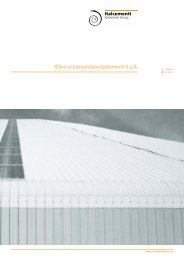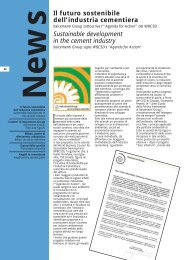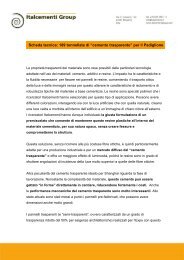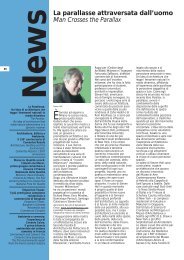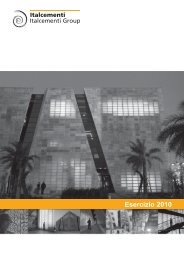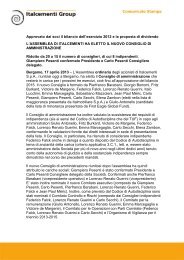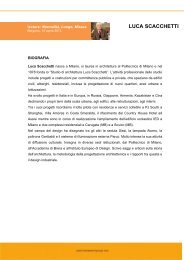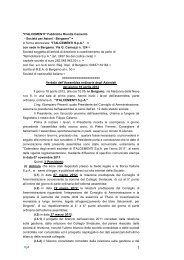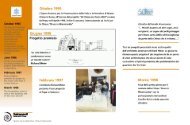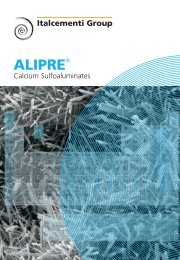2012 Annual Report - Italcementi Group
2012 Annual Report - Italcementi Group
2012 Annual Report - Italcementi Group
Create successful ePaper yourself
Turn your PDF publications into a flip-book with our unique Google optimized e-Paper software.
<strong>2012</strong> <strong>Annual</strong> <strong>Report</strong><br />
Presentation 4<br />
General information 14<br />
<strong>Annual</strong> <strong>Report</strong> Consolidated <strong>Annual</strong> <strong>Report</strong> Directors’ report 30<br />
Sustainability disclosure <strong>Italcementi</strong> S.p.A. <strong>Annual</strong> <strong>Report</strong> Consolidated financial statements 63<br />
Extraordinary session 351<br />
1.2. Accounting policies and basis of presentation<br />
The consolidated accounts adopt the cost principle, with the exception of derivatives and financial assets held<br />
for trading or for sale, which are stated at fair value. The carrying amounts of hedged assets and liabilities are<br />
adjusted to reflect changes in fair value on the basis of the hedged risks. The consolidated financial statements<br />
are presented in euro. All amounts in the accounting schedules and in the notes are rounded to thousands of<br />
euro, unless otherwise specified.<br />
The basis of presentation of the <strong>Group</strong> financial statements is as follows:<br />
current and non-current assets and current and non-current liabilities are presented as separate classifications<br />
on the face of the statement of financial position. Current assets, which include cash and cash equivalents, are<br />
assets that the <strong>Group</strong> intends to realize, sell or consume during its normal business cycle; current liabilities are<br />
liabilities that the <strong>Group</strong> expects to settle during the normal business cycle or in the twelve months after the<br />
end of the reporting period;<br />
on the income statement, costs are analyzed by the nature of the expense;<br />
with regard to comprehensive income, the <strong>Group</strong> presents two statements: the first statement reflects<br />
traditional income statement components and the profit (loss) for the period, while the second statement,<br />
beginning with the profit (loss) for the period, presents other comprehensive income, previously reflected only<br />
in the statement of changes in consolidated equity: fair value gains/losses on available-for-sale financial assets<br />
and derivatives, currency translation differences;<br />
on the statement of cash flows, the indirect method is used.<br />
Use of estimates<br />
The preparation of the consolidated financial statements and the notes in conformity with the international<br />
financial reporting standards requires management to make discretional assessments and estimates that affect<br />
the values of assets, liabilities, income and expense, such as amortization, depreciation and provisions, and<br />
the disclosures on contingent assets and liabilities in the notes.<br />
Since these estimates are determined on a going-concern basis, using the information available at the time,<br />
they could diverge from the actual future results. This is particularly evident in the present financial and<br />
economic crisis, which could generate situations diverging from those estimated today and require currently<br />
unforeseeable adjustments, including adjustments of a material nature, to the carrying amounts of the items in<br />
question.<br />
Assumptions and estimates are particularly sensitive with regard to measurement of non-current assets, which<br />
depends on forecasts of future results and cash flows, measurement of contingent liabilities, provisions for<br />
disputes and restructurings and commitments in respect of pension plans and other long-term benefits.<br />
Management conducts regular reviews of assumptions and estimates, and immediately recognizes any<br />
adjustments in the financial statements.<br />
Given that the <strong>Italcementi</strong> <strong>Group</strong> applies IAS 34 “Interim financial reporting” to its half-year reports, with<br />
consequent identification of a six-month interim period, any reductions in value are recorded at closure of the<br />
half year.<br />
73<br />
www.italcementigroup.com




